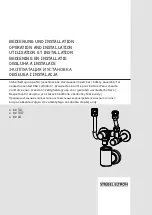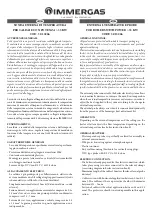
8
Filling the heating system and checking the supply of ventilation
air
!
Please note
Unsuitable fill water increases the level of deposits and corrosion and may
lead to boiler damage.
■ Thoroughly flush the entire heating system prior to filling it with water.
■ Only use fill water of potable quality.
■ Fill water, the hardness of which exceeds the following values, must be
softened, for example with a small softening system for heating water (see
Vitoset pricelist):
– Vitocrossal 300 up to 45 kW: 16.8 °dH (3.0 mol/m
3
)
– Vitocrossal 300 from 60 kW: 11.2 °dH (2.0 mol/m
3
)
■ An antifreeze additive suitable for heating systems can be added to the fill
water. The antifreeze manufacturer must verify its suitability, since other-
wise damage to gaskets and diaphragms can occur as well as noise during
heating operation. Viessmann accepts no liability for damage or conse-
quential damage.
1.
Check whether the ventilation air
supply is unrestricted.
2.
Check the pre-charge pressure of the
diaphragm expansion vessel when
the system is still cold.
Note
If the pre-charge pressure of the dia-
phragm expansion vessel is lower
than the static pressure of the sys-
tem, top up with nitrogen until the pre-
charge pressure (0.1 to 0.2 bar) is
higher than the static system pres-
sure. The static pressure corre-
sponds to the static head.
3.
Open any installed check valves.
4.
Fill the heating system with water and
vent it, until the fill pressure (0.1 to 0.2
bar) is higher than the pre-charge
pressure of the diaphragm expansion
vessel.
Permiss. operating pressure: 3 bar
Min. operating pressure: 1 bar
Commissioning, inspection, maintenance
Further details regarding the individual steps
5692 860 GB
Summary of Contents for CU3A
Page 147: ...147 5692 860 GB ...









































